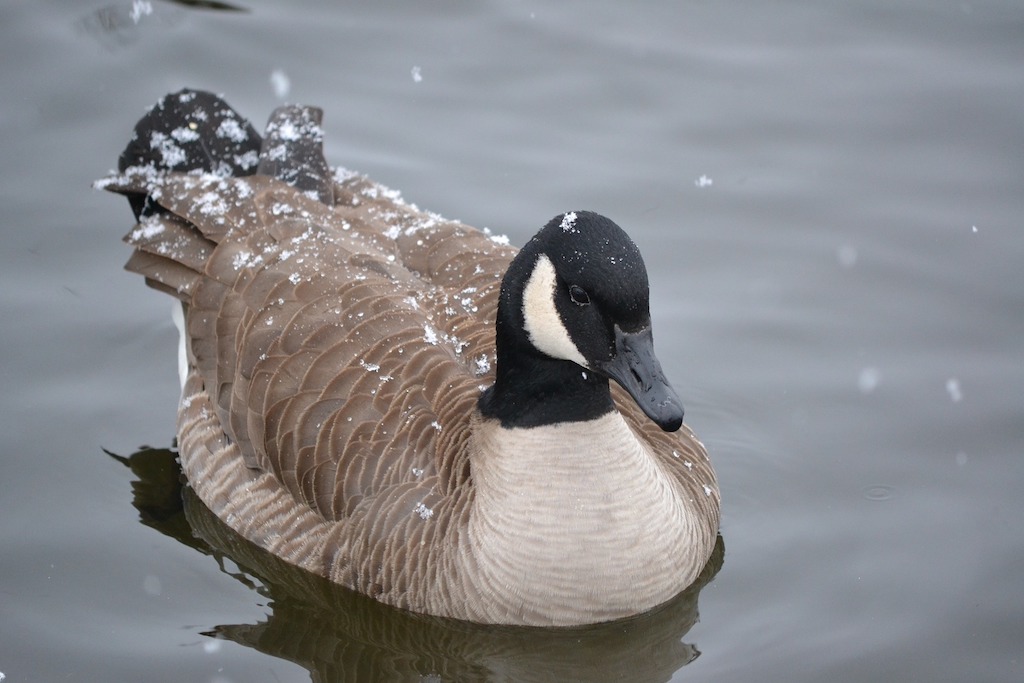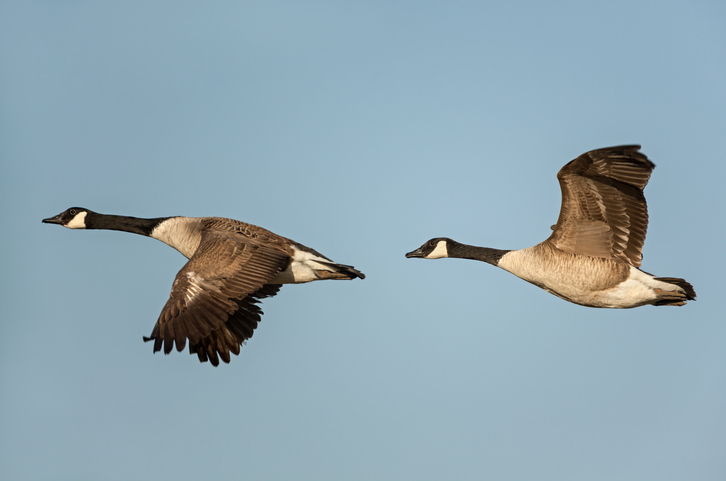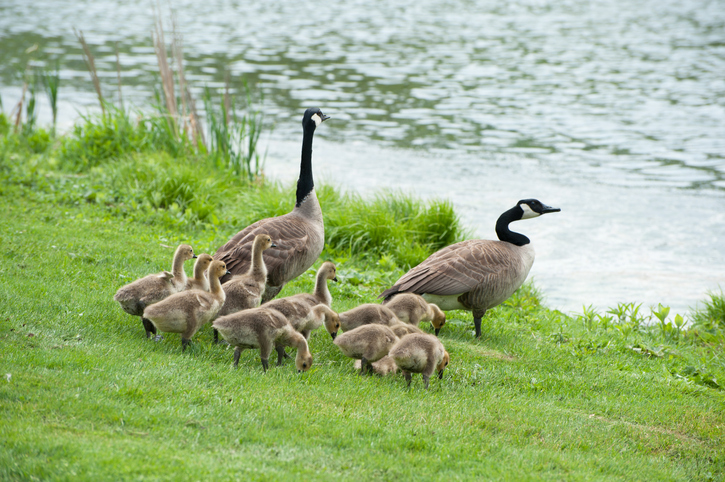
Geese are part of our campus community
Things to know about our campus wildlife
The fowl-lowing piece is by Dr. L. James Shapiro, Director, Avian Behaviour Laboratory, Department of Psychology.
Soon you will begin to see more geese on campus – again. A lot of geese. What should you know about them?
Geese are Winnipeggers, too
Well, first, you should know that it is the female that shows her mate where they should go to nest. The female goose is hatched in an area known as her natal area. She migrates south with her parents and learns how to get to her overwintering area and how to return to her natal area. When she is about two or three years of age, she meets, dates, and “marries” a strange male who also migrated with his parents to the same overwintering area. The pair will remain “mated” for the duration of their lives. The female brings her new mate back to her natal area.
So guess what? All of these nesting female geese are Winnipeggers, just like most of you.
We share our common bond to Winnipeg, its amenities, weather, and everything else that makes Winnipeg what it is. One could argue, therefore, that we should view these geese with some degree of shared values. We should not try to scare them, intrude on their territory, make them feel threatened, or otherwise act in a way that may endanger them or you.

Two Flying Canada Geese (Branta canadensis).
What should you do if you encounter a pair of geese?
First, consider the timing. Is the encounter early in the nesting season, say in the next few weeks? Or is it later in the nesting season when the female is sitting on her nest and incubating her eggs?
If your encounter is early in the season, when the female is looking for a suitable location to build her nest, stop approaching the pair and reverse your direction of travel. Alternatively, make a wide detour around the pair. As you are trying to avoid the pair of geese, they will also try to avoid you and may, I say may, move away from you. Let the female of the pair search for her nesting area in peace. Recognize that the male is protecting his mate. If you get too close, he will become defensive.
What will happen if you continue on your path of travel or decide to get closer to the geese, for whatever reason? Perhaps you want to take a picture of them. Perhaps you want to get closer to observe them out of curiosity. What do you think will happen?
Before I answer, let me ask you: “What would you do if someone began violating your personal space in a situation in which you could not move away?” Maybe you would call 911. Maybe you would call for help. Maybe you would blow a whistle. But what happens if you have no other choice but to fight back? If you could not flee, you would fight. That is the position in which you have put the pair of geese.
Geese have no cell phones. They cannot call friends to help them and they cannot blow a whistle. They have only themselves to rely upon. If they can fly away, they will. But if they do not have the room to “taxi” before taking off, they will fight. Not both of them, but only the male. For him, this is a violation of his personal space and, as a result, the safety of his mate. He will attack because he has no other choice.
The gander is big; he is powerful. He will run at you while he spreads his wings. If you run away, run fast. When the gander feels you are no longer a threat to him and his mate, he will stop chasing you.
What if you disturb the pair of geese when the female is sitting on her nest? Under those conditions, the gander will hiss, erect his feathers to make himself look bigger than he actually is, and he may very well run full tilt at you.
You have two options: run or make yourself look bigger by spreading your arms, like he has spread his wings, and run at him. Call his bluff. But do you want to do that? The odds are not in your favour.
My suggestion is not to approach the nesting pair, at any time, for any reason. As fellow Winnipeggers, that is the least that we can do.
To report a problematic encounter with a goose, contact Physical Plant at 204-474-6281 or email: goose [at] umanitoba [dot] ca
Waterfowl and facts
Scouting locations
Where is the female likely to establish her nest? Wild geese, nesting on the tundra in the far north, where there are few trees, prefer raised areas called hummocks. These are grassy knolls where the male can survey the area surrounding his mate’s nest and detect an approaching predator. The female can use material found on the hummock to build her nest.
This tendency to seek out an elevated area on which to nest translates into rooftops or canopies protecting building entrances on our campus. It could also be on top of a planter or on a slope adjacent to a campus building. [Note: This year, planters have been covered with special materials to deter nesting.] It could be any one of many locations on our campus having some of these characteristics. Or it could be any location that satisfies some need of the female. Hence, one should be aware that one can “trip over” a nesting pair of geese anywhere on our campus.
Building the nest and laying the eggs
What happens after the female goose selects her nesting site? After she selects a site, she begins to erect a nest bowl by sitting in place and using her long neck to pick up appropriate material and retrieve it to her sides. She does this systematically, slowly erecting the walls of the nest around her. She lines the nest with down she plucks from herself. And then?
Then she lays her eggs. Eggs in a nest are called a clutch. The average clutch size of the Canada goose is seven to nine eggs. She lays close to one egg per day. Hence, it takes about one week for the female to complete her clutch. All during this time, the male is guarding the female. He is highly sensitive to any potential threat to his mate.
Goose futures: hatching the eggs
It is supremely important for both the male and female goose to hatch their eggs. By so doing, their genes get into their species’ gene pool. It is only by successfully hatching their goslings that they can communicate with the future. They cannot write a book, paint a picture, cure some disease, write an essay, compose a song or in some other way communicate with the future. They can only reproduce successfully to communicate with their future. Hence, the male will guard his nesting mate with every ounce of strength he has, using every sense he possesses, every minute of every day.
It takes 28 days for the eggs to hatch. At the time of hatching, the male goose is very close to the nest. While he may maintain a large territory surrounding his nesting mate while she is incubating, when the eggs hatch, he maintains a very small area surrounding the female and her goslings.

Canada geese and goslings feeding on grass.
Gosling time
Upon hatching, the female goose will keep the goslings warm until they dry off. Usually, this takes approximately 24 hours. When the goslings are dry, the female goose will leave her nest. The goslings will follow her. The male accompanies his mate and his offspring. Usually one parent will lead the goslings and the other parent will bring up the rear. If they are near water, the parents will lead the goslings to the water. It is there that the goslings attain some degree of safety and the parents are less susceptible to predation.
Respect geese as part of our campus experience
All of the behaviour patterns that I have described in a mated pair of geese take place in the midst of all of the activities occurring on our campus. These geese are used to those activities, used to human beings, cars, traffic, tractors, indeed, all human activity. The geese are aware of us and respect our presence. They do not try to intrude upon our activities. It is very important that we reciprocate and respect their presence and their needs. They are not going to go away. Like the buildings that we enter on campus, we should realize that these geese are also part of our campus. We would not vandalize a building. Why would we want to vandalize the territorial activities of a pair of mated geese?
Canada geese on our campus are part of our campus experience. We should be proud of the fact that we have an environment that can attract and support these birds. We should strive to protect them. We should not take selfies with the geese. We should not smoke around them. We should not throw items at them. We should not feed them. We should not antagonize them. Individuals engaging in such activities should be reported to Campus Security.
Support efforts
If you want to help our geese, support the activities being initiated by our university to protect them and to protect you. Support efforts to encourage different departments to come up with innovative means of contributing to the protection of our geese. Do not enter their personal space. Most importantly, honour their presence with the respect that they deserve.
Dr. L. James Shapiro
Director, Avian Behaviour Laboratory
Department of Psychology
 This story is part of the U of M’s “Respect the Goose” education and awareness campaign regarding the goose population on the Fort Garry campus with input from internal and external experts and other stakeholders. Respect the Goose series: news.umanitoba.ca/category/respect-the-goose/
This story is part of the U of M’s “Respect the Goose” education and awareness campaign regarding the goose population on the Fort Garry campus with input from internal and external experts and other stakeholders. Respect the Goose series: news.umanitoba.ca/category/respect-the-goose/
Read more here: Geese who’s back?, here: Can’t we all just goose along? Tips for cohabiting with campus wildlife and here: Take a gander: Nesting locations, geese population management, community safety — now with interactive map!
Or follow us on social media here: https://twitter.com/umanitoba #respectthegoose







Thanks for this. I look forward to seeing the geese every year (even if their presence sometimes leaves my shoes soiled). It’s good to know that the University is supporting their right to habitat. I was worried that the university might be working to lower their reproduction.
Thanks for the info about nesting and protective habits… very useful.
A great reminder to be tolerant of our feathered family and keep them safe.